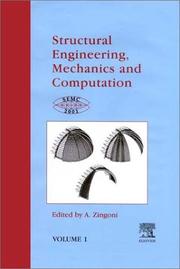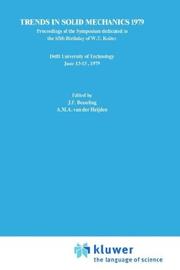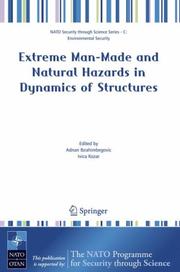| Listing 1 - 7 of 7 |
Sort by
|

ISBN: 128288672X 9786612886720 0080541925 0080439489 9780080439488 9780080541921 6612886722 Year: 2001 Publisher: Amsterdam ; New York : Elsevier,
Abstract | Keywords | Export | Availability | Bookmark
 Loading...
Loading...Choose an application
- Reference Manager
- EndNote
- RefWorks (Direct export to RefWorks)
Following on from the International Conference on Structural Engineering, Mechanics and Computation, held in Cape Town in April 2001, this book contains the Proceedings, in two volumes. There are over 170 papers written by Authors from around 40 countries worldwide. The contributions include 6 Keynote Papers and 12 Special Invited Papers. In line with the aims of the SEMC 2001 International Conference, and as may be seen from the List of Contents, the papers cover a wide range of topics under a variety of themes. There is a healthy balance between papers of a theoretical nature, concerned wit

ISBN: 9028606998 9789028606999 Year: 1979 Publisher: Delft Delft University Press
Abstract | Keywords | Export | Availability | Bookmark
 Loading...
Loading...Choose an application
- Reference Manager
- EndNote
- RefWorks (Direct export to RefWorks)
Book
ISBN: 0962330604 9780962330605 Year: 1989 Publisher: Los Angeles: AASMiRT,
Abstract | Keywords | Export | Availability | Bookmark
 Loading...
Loading...Choose an application
- Reference Manager
- EndNote
- RefWorks (Direct export to RefWorks)
Nuclear reactors --- Structural analysis (Engineering) --- Fusion reactors --- Nuclear power plants --- Design and construction --- Congresses. --- Nuclear reactors - Congresses --- Nuclear reactors - Design and construction - Congresses --- Structural analysis (Engineering) - Congresses. --- Nuclear reactors - Design and construction - Congresses. --- Fusion reactors - Design and construction - Congresses. --- Nuclear power plants - Congresses.
Book
ISBN: 9048181747 140209633X 9786612019500 1282019503 1402096348 9522800171 Year: 2009 Publisher: Dordrecht : Springer Netherlands : Imprint: Springer,
Abstract | Keywords | Export | Availability | Bookmark
 Loading...
Loading...Choose an application
- Reference Manager
- EndNote
- RefWorks (Direct export to RefWorks)
To determine most exactly the carrying capacity of a structure or a structural element has always been a major concern to any design engineer. For safety sensitive structures this implies not only situations of normal service conditions but also states near to failure or post-critical states in order to better prevent accidents by appropriate design. Among the rational design tools available to engineers, for this purpose the so-called "direct methods", embracing in particular limit- and shakedown analysis, have always been particularly attractive due to the fact that they allow to determine in a constructive way directly the limit loads of a structure. This holds true for simple loading by proportionally applied mechanical and thermal loads, but also for the more complicated situation of variable loading even in the case when the loading history is not deterministically given. The tremendous progress in computation over the last years has contributed very largely to the development of direct methods. They have left the realm of ad-hoc computing and can be used today for post-processing in combination with commercial design tools. Far from being comprehensive, given this very active field of scientific research and development, the papers presented in this book give an account of some of the most advanced results achieved over the last years by leading scientists in the field. This way, the book is meant to help the practical engineer to choose the right tool for his safety analysis of critical structures and to stimulate researchers to enter this most interesting field, reaching from highly abstract concepts up to the essential questions of practical engineering.
Plastic analysis (Engineering). --- Plastic analysis (Engineering) -- Congresses. --- Structural analysis (Engineering). --- Structural analysis (Engineering) -- Congresses. --- Building materials. --- Engineering design. --- Design, Engineering --- Engineering --- Architectural materials --- Architecture --- Building --- Building supplies --- Buildings --- Construction materials --- Structural materials --- Design --- Materials --- Engineering. --- Computational intelligence. --- Continuum mechanics. --- Structural mechanics. --- Civil engineering. --- Continuum Mechanics and Mechanics of Materials. --- Structural Mechanics. --- Computational Intelligence. --- Engineering Design. --- Civil Engineering. --- Industrial design --- Strains and stresses --- Public works --- Architectural engineering --- Engineering, Architectural --- Structural mechanics --- Structures, Theory of --- Structural engineering --- Mechanics of continua --- Elasticity --- Mechanics, Analytic --- Field theory (Physics) --- Intelligence, Computational --- Artificial intelligence --- Soft computing --- Construction --- Industrial arts --- Technology --- Mechanics. --- Mechanics, Applied. --- Solid Mechanics. --- Applied mechanics --- Engineering, Mechanical --- Engineering mathematics --- Classical mechanics --- Newtonian mechanics --- Physics --- Dynamics --- Quantum theory
Book

ISBN: 140209230X 9048180945 1402092318 Year: 2009 Publisher: Dordrecht : Springer Netherlands : Imprint: Springer,
Abstract | Keywords | Export | Availability | Bookmark
 Loading...
Loading...Choose an application
- Reference Manager
- EndNote
- RefWorks (Direct export to RefWorks)
This book contains a collection of full papers presented at the ECCOMAS Multidisciplinary Jubilee Symposium -- New Computational Challenges in Materials, Structures, and Fluids, held in Vienna, Austria, February 18-20, 2008. Computational challenges in materials, structures, and fluids, with a focus on multidisciplinarity and multi-scale analysis, are a hot topic in the engineering sciences (aerospace, civil, mechanical, etc.). Modern society in general and applied engineering sciences in particular are confronted with problems with levels of complexity never encountered before in the history of mankind. The solution of scientific problems involving fluids together with solids and structures, not to forget materials, is of paramount importance in a technical world of rapidly increasing sophistication, referred to as the Leonardo World by the eminent German philosopher Jürgen Mittelstrass. With this in mind, the ECCOMAS Managing Board decided to bring the principles of Applied Sciences into focus of the Jubilee Symposium by reconsidering the sources of relevant knowledge on processes occurring at different spatial and temporal scales. They are related to phenomena on different levels such as the nano-, micro-, meso-, and the macro level.
Fluids --Congresses. --- Materials --Congresses. --- Structural analysis (Engineering) --Congresses. --- Materials --- Structural analysis (Engineering) --- Fluids --- Computer Science --- Materials Science --- Engineering & Applied Sciences --- Chemical & Materials Engineering --- Fluid-structure interaction --- Engineering. --- Applied mathematics. --- Engineering mathematics. --- Computational intelligence. --- Fluid mechanics. --- Automotive engineering. --- Biomedical engineering. --- Engineering Fluid Dynamics. --- Automotive Engineering. --- Computational Intelligence. --- Appl.Mathematics/Computational Methods of Engineering. --- Biomedical Engineering. --- Clinical engineering --- Medical engineering --- Bioengineering --- Biophysics --- Engineering --- Medicine --- Hydromechanics --- Continuum mechanics --- Intelligence, Computational --- Artificial intelligence --- Engineering analysis --- Mathematical analysis --- Construction --- Industrial arts --- Technology --- Mathematics --- Soft computing --- Hydraulic engineering. --- Mathematical and Computational Engineering. --- Biomedical Engineering and Bioengineering. --- Engineering, Hydraulic --- Fluid mechanics --- Hydraulics --- Shore protection
Book
ISBN: 9048123844 9048123860 9048123852 Year: 2009 Publisher: Dordrecht, Netherlands : Springer,
Abstract | Keywords | Export | Availability | Bookmark
 Loading...
Loading...Choose an application
- Reference Manager
- EndNote
- RefWorks (Direct export to RefWorks)
1.1. SAFETY OF CIVIL STRUCTURES Society expects that the failure of civil structures is extremely rare and relies on the care and expertise of the professionals involved in the design, construction and maintenance of structures. This is in particular true for public technical systems such as transportation or energy supply systems and structures such as bridges. Structural safety may be defined as follows: “Adequate safety with respect to a hazard is ensured provided that the hazard is kept under control by appropriate measures or the risk is limited to an acceptable value. Absolute safety is not achievable.” It is thus not the structure as such that is designated safe but rather the people, goods and the environment in its surroundings. The continued use of existing structures is of great importance because the built environment is a huge economic and political asset, growing larger every year. Nowadays evaluation of the safety of existing structures is a major engineering task, and structural engineers are increasingly called upon to devise ways for extending the life of structures whilst observing tight cost constraints. Also, existing structures are expected to resist against accidental actions although they were not designed for. Engineers may apply specific methods for evaluation in order to preserve structures and to reduce a client’s expenditure. The ultimate goal is to limit construction intervention to a minimum, a goal that is clearly in agreement with the principles of sustainable development.
Buildings -- Natural disaster effects -- Congresses. --- Disasters -- Congresses. --- Emergency management -- Congresses. --- Structural analysis (Engineering) -- Congresses.Structural analysis (Engineering) -- Congresses. --- Structural analysis (Engineering) --- Disasters. --- Buildings --- Emergency management. --- Natural disaster effects. --- Consequence management (Emergency management) --- Disaster planning --- Disaster preparedness --- Disaster prevention --- Disaster relief --- Disasters --- Emergencies --- Emergency planning --- Emergency preparedness --- Calamities --- Catastrophes --- Architectural engineering --- Engineering, Architectural --- Structural mechanics --- Structures, Theory of --- Management --- Planning --- Preparedness --- Prevention --- Engineering. --- Civil engineering. --- Building. --- Construction. --- Engineering, Architectural. --- Building repair. --- Nature conservation. --- Soil science. --- Soil conservation. --- Waste management. --- Building Construction. --- Nature Conservation. --- Civil Engineering. --- Waste Management/Waste Technology. --- Building Repair and Maintenance. --- Soil Science & Conservation. --- Design and construction. --- Repair and reconstruction. --- Public safety --- First responders --- Building failures --- Natural disasters --- Curiosities and wonders --- Accidents --- Hazardous geographic environments --- Structural engineering --- Waste disposal. --- Building construction. --- Building Construction and Design. --- Conservation of nature --- Nature --- Nature protection --- Protection of nature --- Conservation of natural resources --- Applied ecology --- Conservation biology --- Endangered ecosystems --- Natural areas --- Conservation of soil --- Erosion control, Soil --- Soil erosion --- Soil erosion control --- Soils --- Agricultural conservation --- Soil management --- Engineering --- Public works --- Conservation --- Control --- Buildings—Design and construction. --- Buildings—Repair and reconstruction. --- Pedology (Soil science) --- Agriculture --- Earth sciences --- Building reconstruction --- Building renovation --- Building repair --- Reconstruction of buildings --- Remodeling of buildings --- Renovation of buildings --- Maintenance --- Repairing --- Architecture --- Construction --- Construction science --- Structural design --- Construction industry --- Reconstruction --- Remodeling --- Renovation --- Protection --- Conservation and restoration --- Design and construction --- Emergency management --- War damage --- Natural disaster effects --- Edifices --- Halls --- Structures --- Built environment

ISBN: 9781402056543 1402056540 1402056559 9786610865000 1280865008 1402056567 Year: 2007 Publisher: Dordrecht, Netherlands : Springer,
Abstract | Keywords | Export | Availability | Bookmark
 Loading...
Loading...Choose an application
- Reference Manager
- EndNote
- RefWorks (Direct export to RefWorks)
There is currently ever pressing need to provide a critical assessment of the current knowledge and indicate new challenges which are brought by the present time in fighting the man-made and natural hazards in transient analysis of structures. The latter concerns both the permanently fixed structures, such as those built to protect the people and/or sensitive storage material (e. g. military installations) or the special structures found in transportation systems (e. g. bridges, tunnels), and the moving structures (such as trains, plains, ships or cars). The present threat of the terrorist attacks or accidental explosions, the climate change which brings strong stormy winds or yet the destructive earthquake motion that occurs in previously inactive regions or brings about tsunamis, are a few examples of the kind of applications we seek to address in this work. The common ground for all the problems of this kind from the viewpoint of structural integrity, which also justifies putting them on the same basis and addressing them within the same context, is their sudden appearance, their transient nature and the need to evaluate the consequence for a high level of uncertainty in quantifying the cause. The problems of such diversity cannot be placed within a single traditional scientific discipline, but they call for the expertise in probability theory for quantifying the cause, interaction problems for better understanding the physical nature of the problems, as well as modeling and computational techniques for improving the representation of inelastic behavior mechanisms and providing the optimal design.
Structural analysis (Engineering) --- Structural dynamics --- Hazard mitigation --- Natural disaster warning systems --- Constructions, Théorie des --- Constructions --- Congresses --- Congrès --- Dynamique --- Hazard mitigation -- Congresses. --- Natural disaster warning systems -- Congresses. --- Structural analysis (Engineering) -- Congresses. --- Structural dynamics -- Congresses. --- Physics - General --- Civil Engineering --- Physics --- Civil & Environmental Engineering --- Physical Sciences & Mathematics --- Engineering & Applied Sciences --- Disaster warning systems, Natural --- Warning systems, Natural disaster --- Disaster mitigation --- Hazards mitigation --- Mitigation, Hazard --- Natural hazard mitigation --- Natural hazards mitigation --- Physics. --- Computer software --- Computer mathematics. --- Probabilities. --- Continuum physics. --- Vibration. --- Dynamical systems. --- Dynamics. --- Classical Continuum Physics. --- Computational Science and Engineering. --- Probability Theory and Stochastic Processes. --- Performance and Reliability. --- Vibration, Dynamical Systems, Control. --- Reusability. --- Emergency communication systems --- Emergency management --- Computer science. --- Distribution (Probability theory. --- Operating systems (Computers). --- Classical and Continuum Physics. --- Cycles --- Mechanics --- Sound --- Computer operating systems --- Computers --- Disk operating systems --- Systems software --- Distribution functions --- Frequency distribution --- Characteristic functions --- Probabilities --- Informatics --- Science --- Operating systems --- Computer software—Reusability. --- Probability --- Statistical inference --- Combinations --- Mathematics --- Chance --- Least squares --- Mathematical statistics --- Risk --- Computer mathematics --- Electronic data processing --- Classical field theory --- Continuum physics --- Continuum mechanics --- Dynamical systems --- Kinetics --- Mechanics, Analytic --- Force and energy --- Statics --- Disaster risk mitigation --- Disaster risk reduction --- Disasters --- Reduction of risks of disasters --- Risk mitigation, Disaster --- Risk reduction, Disaster --- Risk mitigation
| Listing 1 - 7 of 7 |
Sort by
|

 Search
Search Feedback
Feedback About
About Help
Help News
News